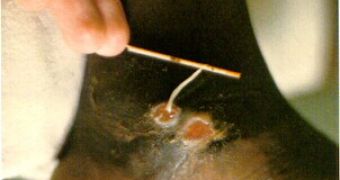1.If you're a veggie, perhaps you enjoy uncooked sprouts of bean, soy, trifle or alfalfa. But research shows they can transmit bacterial infections. The most exposed are small children, elderly and those with a weak immune system. Even washing the sprouts with chlorine or alcohol solutions does not remove germs. The humidity and raised temperature necessary for making the seeds germinate are ideal conditions for the bacteria.
2.Domestic animal wastes in large quantities attract rats, and fleas jumping from rats can transmit plague to people. In India, earth worms, Pheretima elongata, are used in transforming the animal wastes coming from butcheries into organic fertilizers: introduced in waste recipients, the worms can process 4 tons of material daily in Bombay.
3.The demand of the western market for fresh products all year round and a global economy that transports in one night the products all over the world contributed to the spread of infections. Microbes coming from food could infect 6.5 to 81 million persons and kill 9,000 Americans annually. Also, the increase of foods made from crops fertilized with manure aggravates the issue. Escherichia coli (the bacterium involved in most food poisonings) can survive 70 days in cow dung and can breed in aliments fertilized with this dung, if not destroyed by heat or additives, like salt or preservatives.
4.The red wine vinegar is 100 times more effective in disinfecting vegetables contaminated with cholera bacteria than lime chlorine. On lettuce leaves, it reduces by 10,000 times the number of cholera bacteria, compared to 100 times in the case of chlorine. The right mix is of 5 vinegar spoons to one liter of water.
5.After smallpox, dracunculiasis or Guinea worm disease could be the second eradicated human infection. By now there are less than 163,000 infected people, and the disease is dwindling, except in Sudan. The worm is transmitted through larvae in the water, but the disease is already eradicated in Central Asia, Pakistan, and many African countries. The disease was controlled through chemicals cleaning the water, water filtering through a fabric, and impeding the infected people bathing or washing in drinking water sources. Once ingested, the male worms die after mating, while the females grow up to 1 m (3.3 ft) long, after which in a few weeks they form painful pustule on the foot of the victim, which sometimes remains disabled or with muscular lesions.
6.Chicken pox is a common childhood infection, but now it kills increasingly more adults. In 1970, the disease's victims were 48% adults; by 2001 they were 81%. Over 25 people die of chicken pox annually in UK. The most vulnerable are men aged 15 to 44.
7.Three infections provoke 70% of the 13 million child deaths in developing countries: pneumonia, diarrhea and measles, which can be treated or prevented with the existing methods. Diarrhea kills 3 million children annually. 50% of these children could be saved through a cheap oral re-hydrating therapy. Regular hand washing with water and soap decreases the risks by 43%. Cold symptoms too are gone in 45% of the subjects washing their hands with soap five times daily.
8.On your office, the most contaminated objects are: phones, desks, water taps, microwave oven handles and keyboard. On the desk there are 100 times more bacteria than on the kitchen table and 400 more than on the toilet seat.
9.Half of the people touching a hotel's door latches, lamps, phone handsets or TV remote controls catch a cold-causing virus.

 14 DAY TRIAL //
14 DAY TRIAL //